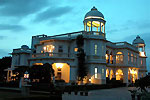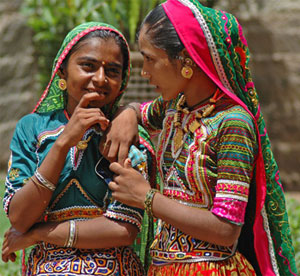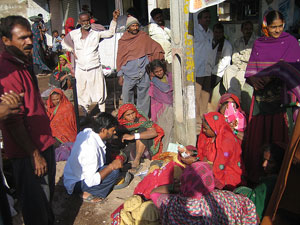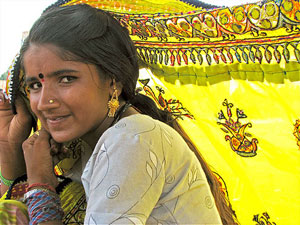|
|
| |
|
Gujarat Tours |
|
|
|
|
| |
|
|
| |
|
|
| |
|
|
| |
|
|
| |
|
Gujarat Hotels |
|
|
 |
|
|
|
|
Gujarat People |
|
|
The People |
|
The majority of the
population is of Indo-Aryan origin. Nearly 20% of the
people are tribal and the Bhils, Kolis, Dhubla, Naikda
and Macchi-Kharwa are some of the tribes which can be
still found in Gujarat. The Aryans were the first
people to come from the north who either conquered or
drove away the Bhils, the traditional rulers of
Gujarat. Kolis are also equally important and occupy
an intermediate social position between the Aryans and
the Bhils. Aryans are now commonly recognized as
Hindus. The immigration during the medieval period
brought Islam and Zoroastrianism to Gujarat and
initiated the growth of a multi-religious society. The
peninsula of Kathiawar is named after the Kathis who
came to Saurashtra at the close of the fourteenth
century. Their origin is not fully known but it is
possible that they were driven southwards by the
Muslim invaders. Khachar and |
 |
|
|
Chotila were the most
important seats of the Kathis. Worshippers of the Sun, they
were essentially nomadic and had developed, among other
pastoral occupations, the art of horse-breeding. Successive
waves of immigrants from other parts of India have led to a
superimposition of different communities and cultures in
Kathiawar. The powerful royal families, which conquered
Saurashtra later on established their rule over there. 'Rabaris'
are community of cattle-breeders who have migrated from
Sindh and Marwar and claim a Rajput ancestry. The Rabaris
stand out prominently by their features and dress and lead a
nomadic life. The tribal people in the hilly areas do
subsistence farming. Rice, jowar, bajra, and groundnut are
the main crops grown by them. The tribals engage themselves
in wood-cutting with which they descend to the small towns
for getting the daily necessaries of life. Many of them are
engaged in forest industry, where they collect lac and
toddy. |
|
|
|
The Gujaratis, the
people of Gujarat, are found all over the state. These
people trace their lineage from the Gurjars. They are
believed to have come to India with the Huns and while
passing through Punjab, settled in Gujarat. Gujaratis
were highly influenced by the cultural waves from the
mainland and accepted the monarchies that ruled over
them. Various Hindu traditions like Shavism and
Vaishnavism were adopted by Gujarat which in turn
developed its own galaxy of saints and devotees and
its own art and culture. Today, the word Gujarati does
not provide any definite association with a particular
stock, a tribe of immigrants or a specific group of
people. The Kutchis, who were the natives of
|
 |
|
|
the peninsula of Kutch,
have their own dialects. The Kutchis are both Hindus and
Muslims and a large number of them have migrated from
Sindh. The Jadeja Rajputs, the Lohanas and even the Muslims
many of whom are 'Maldharis', the cattle-breeders, came from
Sindh. Gujarati males generally wear dhoti, long or short
coat and turban cap. Nowadays, pants are becoming common
instead of dhoti. The women wear saree and blouse. Parsi
males wear pants, long coat and a headgear. The Parsi
women's clothes are identical with those of the Hindu women
with a slight difference marked by long sleeves of the
blouse and a scarf on the head. With the changing times, the
ornaments of the women are also changing. They have become
simpler and meager. They generally wear rings, ear-rings,
bangles and slender chains. Bangles made of ivory and dyed
in red, with a gold chip, are presented to the bride by her
maternal uncle on the occasion of her marriage. |
|
|
|
Religion
The total population of the state consists of Hindus,
Muslims and Jains. Zorastrians or Parsis can also be
seen in Gujarat.
The caste system is
strictly followed by the Hindus of Gujarat. Besides
the 'Brahmins' and the 'Banias' whose functions and
occupations are fairly well determined, the 'Patidars'
or Patels who own land and are the best agriculturists
are the strongest force in the economic and political
life of the state. They are grouped into four
categories namely Levas, Kadawas, Anjana and Uda. The
Levas are most shrewd and are concentrated in central
Gujarat. The |
 |
|
|
Kadawas are found in the
Mehsana district. The fourth regional group which may have
been a native of Gujarat is the community of aboriginals,
locally known as 'Bhils', which inhabit the hilly tracts of
Gujarat that border the plains from Abu in the north to
Dangs in the south. The main tribal groups are the Bhils,
the Dublas, the Naika-Narkdas, the Gamits and the Dhankas.
The Bhils regard themselves as belonging to the Kshatriya
caste who had to take shelter in the hills of the Vindhyas
and the Satpuras, along the lower Narmada, to save
themselves from the wrath of the Brahmin hero, Parashuram.
The Bhils of Gujarat thus do not possess any racial basis
distinct from the other inhabitants of the region. The
tribals of Gujarat are found in the south-eastern part of
Gujarat particularly in the district of Panchmahal, Surat,
Baroda, and Broach. |
|
|
|